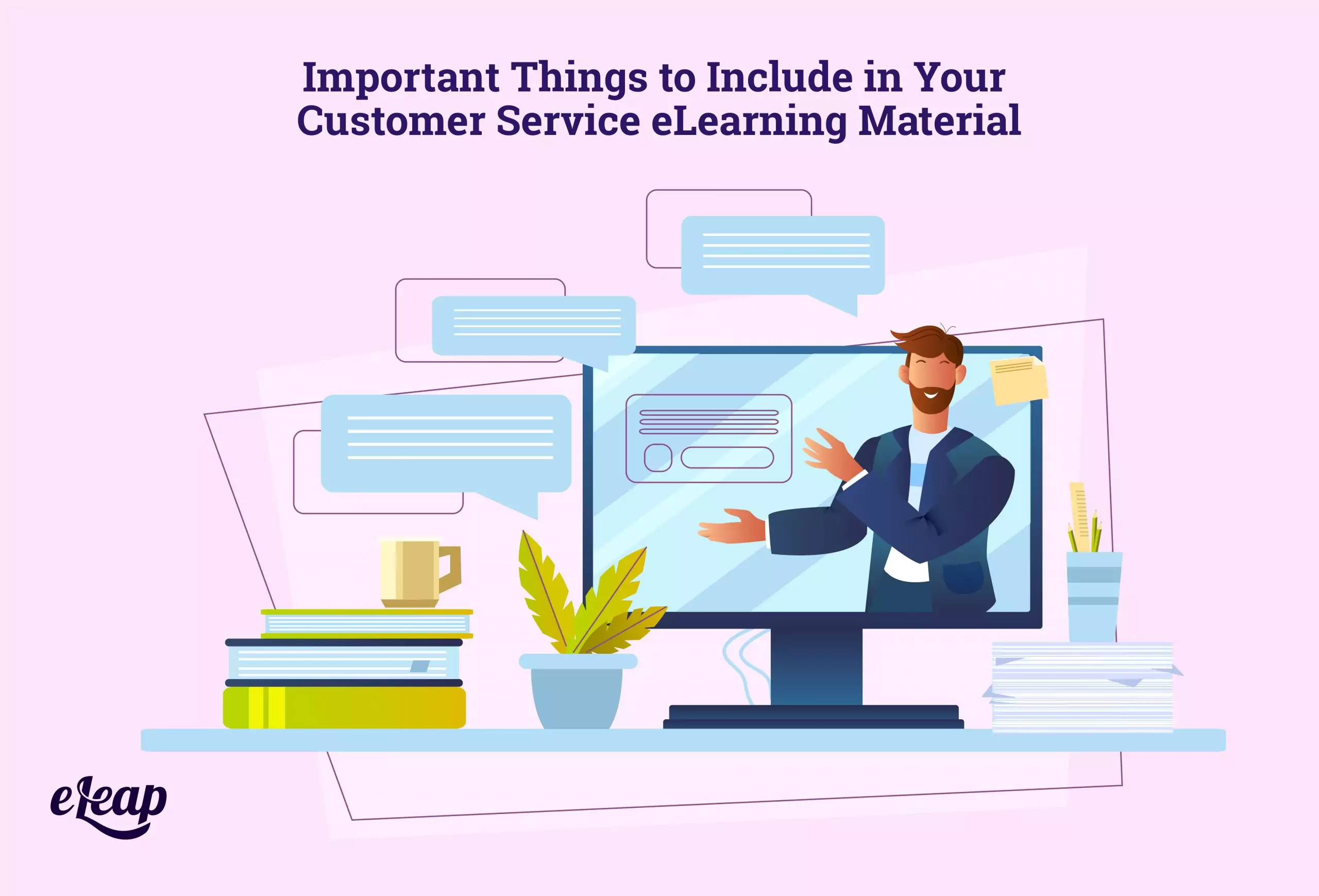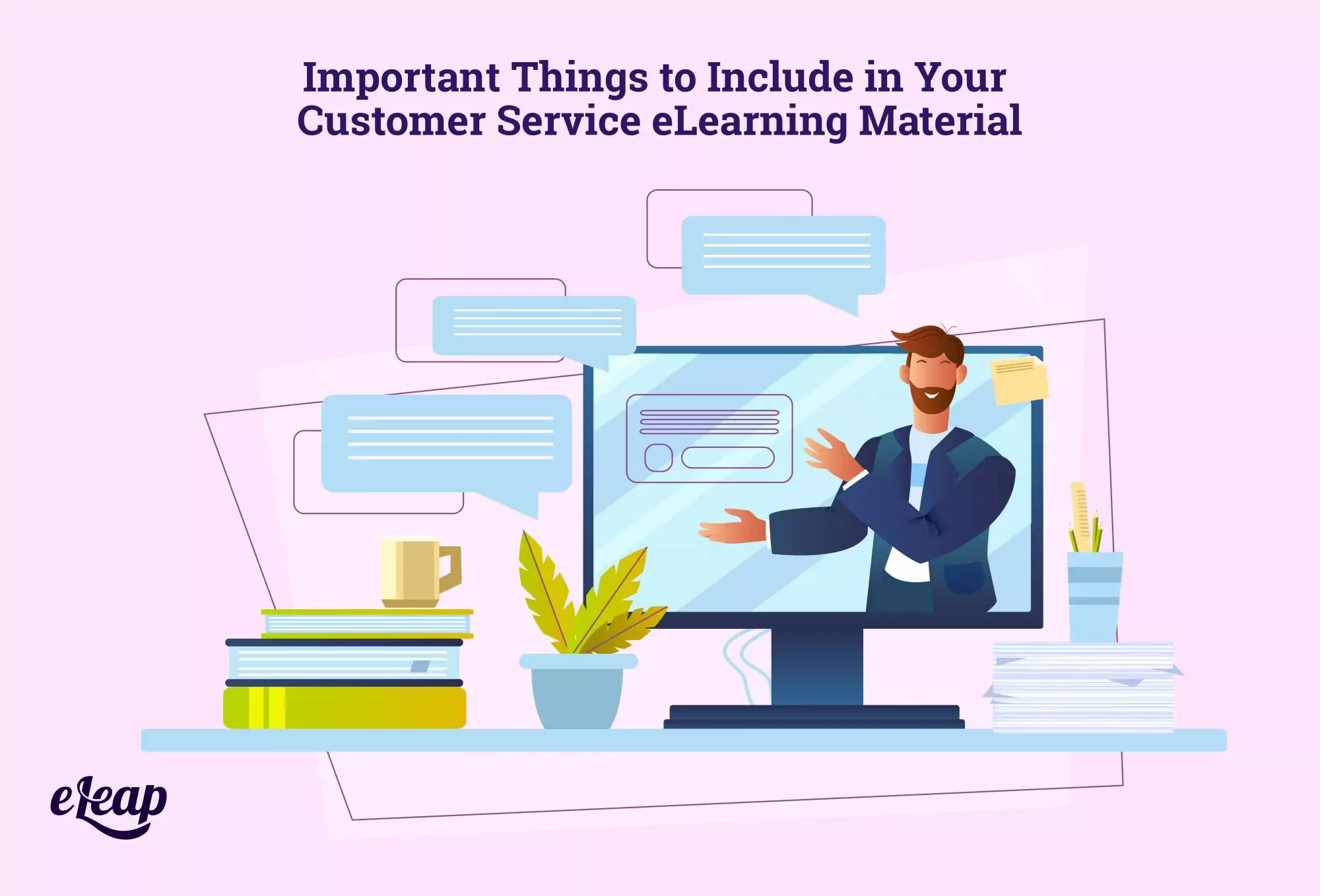Important Things to Include in Your Customer Service eLearning Material

Customer service is more critical than ever before. And, with the increasing competition in all industries and verticals, it will only grow as we move into the rest of the 21st century. Preparing your team for this demand can be challenging, but eLearning can help. With a modern learning management system (LMS), it becomes possible to blend methodologies and close skill gaps that would otherwise cripple your ability to serve your customers.
With that being said, not all customer service material is ideal for inclusion in your eLearning efforts. The seismic shifts in all industries due in large part to the shift towards eCommerce and digital communication are partially responsible for this, but there are other forces at work, too. Because of that, you must have a good understanding of what to include in your customer service eLearning material. Download the Customer Service eBook to learn more.

Soft Skills
The first thing you need to do is ensure that all customer service employees have the foundation necessary to do the job. Customer service is about empathy, communication, and compassion. Without those attributes, your team will be unable to address the underlying issues and build a stronger relationship with your customers. The most important soft skills you should include in your eLearning material include courses/modules on the following:
- Empathy – Putting yourself in someone else’s situation and understanding their pain point from their perspective.
- Persuasion – The ability to persuade a customer to take a particular route for problem resolution.
- Active Listening – This is truly, deeply listening to the customer with the intent of understanding, rather than the intent to respond.
- Positive Language – Positive language uplifts the conversation and smooths jagged nerves.
- Clear Communication – Direct, accurate communication based on problem/resolution is vital in customer service.
Knowledge of Your Customer Service eLearning Offerings
In addition to soft skills, customer service representatives need to have in-depth knowledge about your entire range of offerings, whether those are physical products, intangible products, or services. Ideally, your reps will be users/customers themselves, or have hands-on experience with your offerings.
Customer service reps must have deep knowledge here for a couple of reasons. First, customers have become far more intelligent and have access to an incredibly wide range of resources. It takes nothing to look up basic information about your products for themselves. So, customer service reps must know more about what you offer than your customers do to speak confidently and authoritatively.
Another reason is that only by working with someone who truly knows the product and the challenges they are experiencing can customers enjoy a positive experience. Understand that if they are contacting customer service, their experience has been subpar up to this point. Knowledgeable customer service reps are the key to reversing that downward arc and making a positive change.
Values, Culture, and Mission
Your company’s culture, values, and mission are largely responsible for setting it apart from your competitors. Your customer service team should have a deep understanding of these intangibles. To help build this into your customer service eLearning content, answer a few simple questions:
- Where does the company want to go over time?
- What does it seek to achieve (beyond profitability)?
- What does the company value?
- How does the company uphold its corporate responsibility to the wider community?
- How does the company position itself in the industry?
- In relation to competitors?
- In relation to its customers?
Use the answers to these questions to create training content that helps connect customer service reps with your culture, values, and overall mission. When that happens, they will be able to communicate those to customers with every interaction, delivering a better overall experience and driving improved outcomes.
Use the Right Content Types
With a better understanding of the skills necessary to deliver great customer service, you must now put those into your eLearning content. It’s tempting to go the simplest and most expedient route, which usually involves creating text-based content. However, that does both your customer service team and your customers a disservice.
The right content type can help your learners really absorb the information offered. It can also help ensure that they can retain that information. For instance, consider using experiential training, social training, and formal training methods to deliver the best mix of results. Not sure what each of those entails?
Experiential Training: This type of training involves putting knowledge to work, such as through a simulation. However, it can also include things like posters or guides visible in an employee’s work area that can remind them of important things.
Social Training: Social training puts your learners together so they learn as a group. This does not have to be a classroom setting, though. Learning lunches, mentorship programs, and roleplaying are all examples that work well.
Formal Training: This is where you will find options like instructor-led learning, traditional LMS modules, webinars, and the like. Often, formal learning forms the foundation of your training efforts and is then supplemented by social training and experiential training.
The Importance of Scenarios/Simulations
Call them training scenarios or simulations, the result is the same – a powerful form of learning that really drives home key lessons while encouraging learners to put their knowledge to work in the real world. You can include scenarios in your eLearning content, but you should also create simulations in the real world that put your learners in a position where their knowledge and ability can be tested under real-world conditions and stressors.
Simulations and scenarios allow you to evaluate aspects of employee performance and skills that might be hard to do otherwise. This includes their ability to think on their feet, the ability to use knowledge from their training, and their ability to perform well under pressure.
Here’s to Better Customer Outcomes!
Ultimately, all of your customer service eLearning efforts should be geared toward one thing – satisfying customers and improving their experience. With the right steps and an understanding of what we’ve covered above, it is possible to develop high-performing customer service professionals who help your organization rise above the competition.